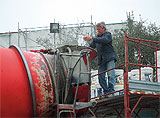Concrete Technology Today – Vol 7 – No 2 2008
The Piazza Leonardo Da Vinci Underground carpark, which is currently under refurbishment, is a three-level, 12 in below-grade parking structure located in the centre of Salo, a popular vacation destination in the southwestern tip of the Lake Garda region, Italy. In waterproofing the concrete of the carpark, the project team was faced with the challenge of a 10 m water table, clay soil conditions and a tight property line that compromised access (shoring was accomplished with 30 cm / 11.8110 in thick diaphragm walls).
 |
|
The base slab, treated with KIM concrete can withstand the 10 m water table, |
In addition, the ground level of the carpark would be permanently landscaped as a piazza (square) and because of this, the project team must seek a reliable, cost-efficient solution that would preserve the integrity of the carpark for years to come.
The project team then decided to choose the Krystol Internal Membrane (KIM), a waterproofing admixture for new construction from Kryton, which was supplied by Kryton’s Italian distributor, System & Project SRL.
The KIM system was applied internally in the I m thick base slab, in all the perimeter walls and the ground-level plaza deck. Added directly to the concrete mixer at the batch plant or job site, KIM protects against water intrusion, leakage, cracking, chemical attack and corrosion of reinforcing steel. A total of 20,000 kg of KIM was used in 2,500 cu m of concrete for the project.
KIM is based on integral crystalline waterproofing technology, which uses a chemical reaction to turn concrete into a permanent, waterproof barrier. When added or applied to concrete, crystalline chemicals create a reaction that causes long, narrow crystals to form, filling the pores, capillaries and hairline cracks of concrete. As long as moisture remains present, crystals continue to grow throughout the concrete, reaching lengths of many inches over time.
Crystalline applications become even more effective with time. The crystalline chemicals sit dormant until cracks form in the concrete due to curing shrinkage, settling or seismic activity. Then any water entering through cracks causes new crystals to form and grow, blocking and filling those cracks. Crystalline-treated concrete’s ability to self-seal cracks is a unique and highly useful feature, and can help to dramatically reduce the long-term maintenance and repair costs of a concrete structure.
 In addition, Krystol Waterstop System, an advanced joint design system that provides both chemical and physical waterproofing barriers were applied in all the cold joints of all the slab-towall joints. In following the original specifications, the project team took the precautionary step of applying the Krystol Waterstop System in conjunction with bentonite strips on all slab-to-slab and wall-to-wall joints. Hundreds of lineal meters of the Krystol Waterstop System were used for the project.Crystalline applications become even more effective with time. The crystalline chemicals sit dormant until cracks form in the concrete due to curing shrinkage, settling or seismic activity. Then any water entering through cracks causes new crystals to form and grow, blocking and filling those cracks. Crystalline-treated concrete’s ability to self-seal cracks is a unique and highly useful feature, and can help to dramatically reduce the long-term maintenance and repair costs of a concrete structure.
In addition, Krystol Waterstop System, an advanced joint design system that provides both chemical and physical waterproofing barriers were applied in all the cold joints of all the slab-towall joints. In following the original specifications, the project team took the precautionary step of applying the Krystol Waterstop System in conjunction with bentonite strips on all slab-to-slab and wall-to-wall joints. Hundreds of lineal meters of the Krystol Waterstop System were used for the project.Crystalline applications become even more effective with time. The crystalline chemicals sit dormant until cracks form in the concrete due to curing shrinkage, settling or seismic activity. Then any water entering through cracks causes new crystals to form and grow, blocking and filling those cracks. Crystalline-treated concrete’s ability to self-seal cracks is a unique and highly useful feature, and can help to dramatically reduce the long-term maintenance and repair costs of a concrete structure.